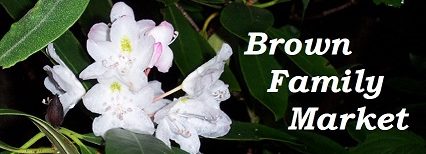How much caffeine is there in coffee? Well, it depends on the beans. According to Coffee Chemistry, a Robusta bean is 2.2% caffeine, while an Arabica bean is 1.2% caffeine. Therefore, Robusta coffee beans often have 83% more caffeine than Arabica beans. So, this makes it important to know which type of coffee bean you are making your coffee from. In this article, I will share Coffee History and Amazing Facts. They will educate you and provide you the data you need to be a Coffee Aficionado.
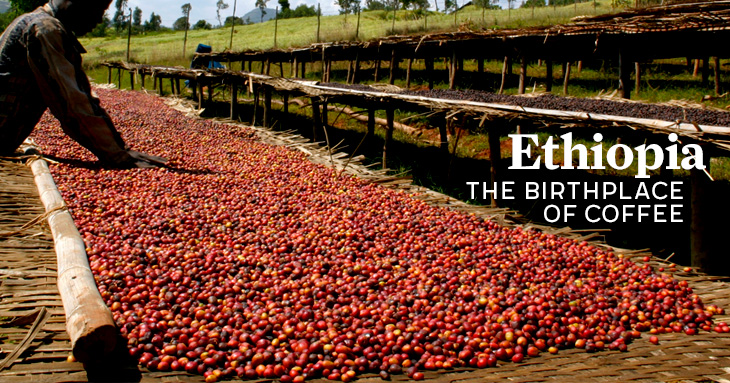
Coffee History – Origin
Coffee History originated in the Horn of Africa, specifically in the highlands of the Ethiopian plateau. In the south and central regions of Ethiopia, where wild coffee trees still grow. The origin of the English word “Coffee” is from the name Kaffa, a province in southwest Ethiopia. So, from Ethiopia, the coffee bean made its way to the Arabian Peninsula. According to the National Coffee Association, by the 15th century, coffee grew in the Yemeni district of Arabia. That is the current country of Yemen. Also, by the 16th-century coffee was known and consumed in Persia, Egypt, Syria, and Turkey.
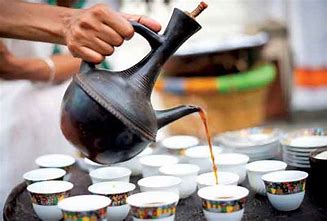
Coffee History – Coffee Houses
Similar to the modern “corner bar,” the people of the Arabian Peninsula and also the Middle East started to build Coffee Houses. The people would sit, talk, listen to music, and indulge in other entertainment while drinking coffee. During that time coffee began to be referred to as “wine of Araby.” These coffee houses flourished and even welcomed the annual pilgrims to Mecca. Coffee was an integral part of 16th century Arabia as well as the Middle East. So, coffee’s cultural importance continues in this region through today as well as into the foreseeable future.
Coffee History – European Invasion
People from Europe traveling in the Near East brought back stories of an unusual dark black beverage. Hence, by the 17th century, coffee had made its way to Europe. Once there, it became popular across the continent. According to the National Coffee Association, “Some people reacted to this new beverage with suspicion or fear.” They call it the “bitter invention of Satan.” So, the Clergy in Venice condemned the beverage in 1615. It was so controversial that Pope Clement VIII was asked to intervene. He tasted the beverage for himself before deciding to condemn or approve the beverage. Consequently, the Pope found the drink so fulfilling that he gave it papal approval. This led to Coffee houses springing up in England, Austria, France, Germany, and Holland. Prior to coffee, the usual breakfast beverages were beer or wine. But Coffee quickly became the breakfast beverage of choice during this period.
Boston Tea Party
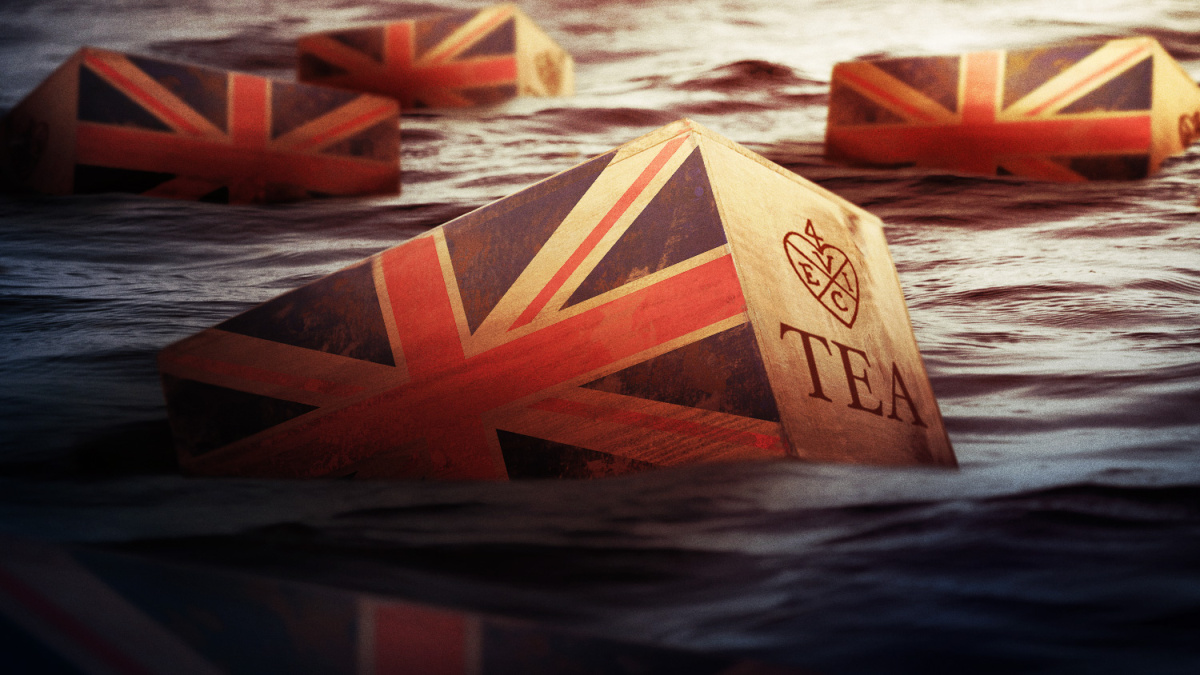
Coffee History – The New World Dumps Tea for Coffee
Tea continued to be the favored drink in the American colonies until 1773. This is when the colonists revolted against a heavy tax on tea imposed by King George III. The revolt, also known as the Boston Tea Party, changed how we thought about tea. This event forever changed our American drinking preference from tea to coffee. Consequently, much to the humiliation of the British. While Coffee cannot grow in the continental United States, it is grown in Hawaii, the Caribbean, Central, and South America. So, the new world is a great place to grow and enjoy coffee.
“Coffee – the favorite drink of the civilized world.” – Thomas Jefferson
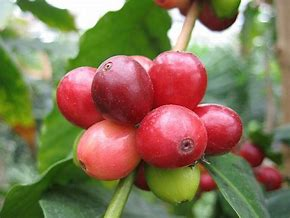
What is Coffee?
Coffee “beans” are actually the pits of Coffee Tree Cherries. Coffee trees, which can grow up to 30 feet tall, as mentioned, produce a fruit known as Coffee Cherries. The pits from the fruit are usually present in pairs. So, two coffee beans per coffee cherry. If there is only one bean in the fruit it is referred to as a peaberry. These peaberries are thought to be sweeter and more flavorful. So, they are often separated out and sold separately. Sold at a premium price too, I might add. Peaberry Coffee makes up about 5% of the coffee produced. Furthermore, after the bean harvest, they separate them from the fruit and roast them. They then grind and brew the coffee. Coffee plants can produce as trees or as shrubs. But either way, they produce a wonderful beverage.
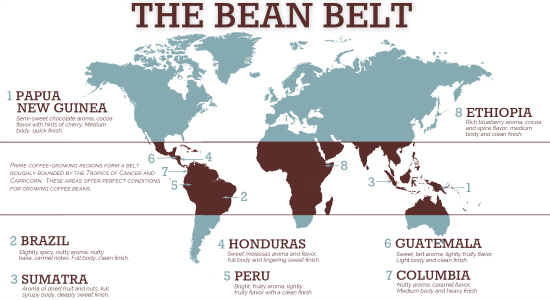
Coffee Growing Today
Today Coffee is grown within the Coffee Belt. [See the Coffee Belt Map above.] The Equatorial zone also called “The Bean Belt,” is located between latitudes 25 degrees North and 30 degrees South. The biggest producer is Brazil, followed by Vietnam. But all the producers throughout the Coffee Belt produce the coffee in locations that are frost-free zones. The best coffees grow at elevations 3,000-5,000 feet above sea level. Coffee can grow up to 6,000 feet above sea level as long as it’s below the frost zone. The elevation plays an important part in the flavor of the coffee. [See the graphic below.]
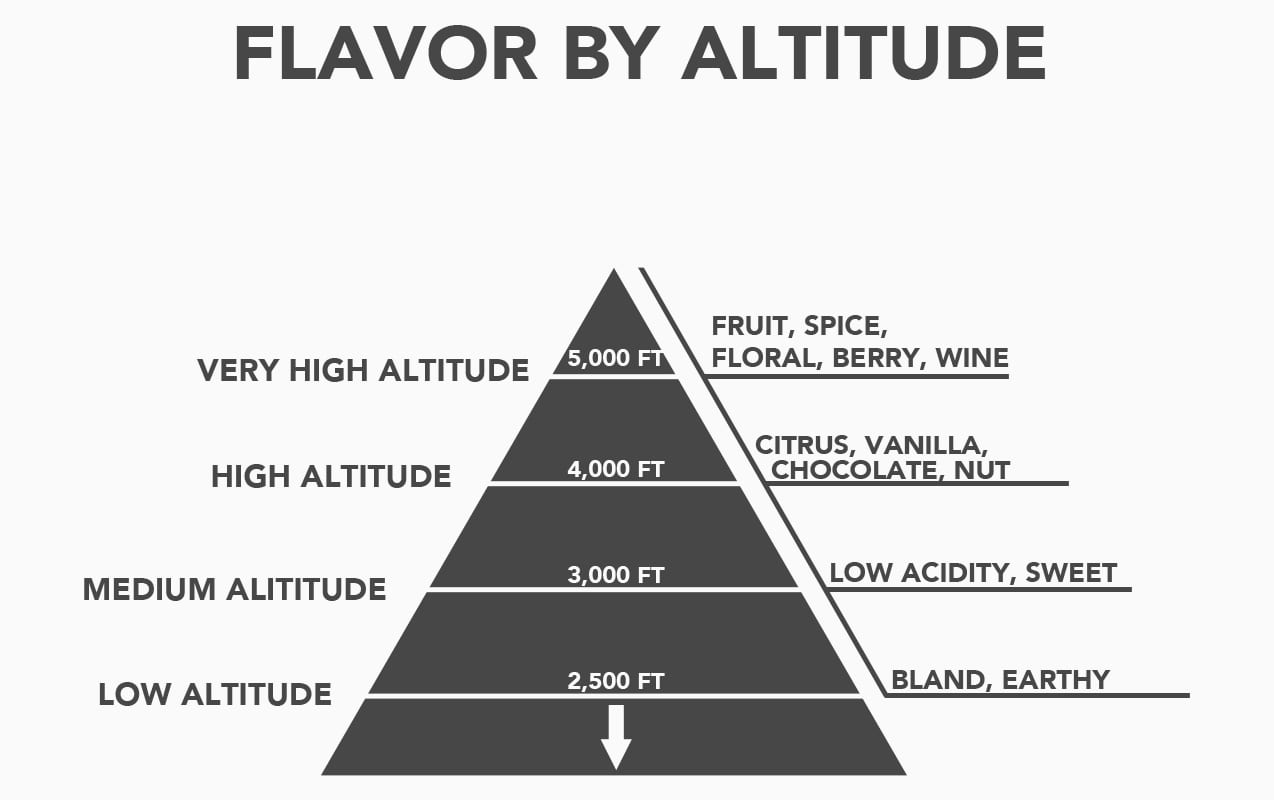
Arabica Coffee Beans
Coffea Arabica is the botanical name. They descended from the original coffee trees discovered in Ethiopia. These trees produce a mild, aromatic coffee as well as represent about 60-70% of the world’s coffee production. The beans are flatter and more elongated than Robusta beans. Arabica beans also have less caffeine. They grow between 2,000 to 6,000 feet above sea level. Also, they grow in temperatures of 59 – 75 degrees Fahrenheit, in areas that receive about 60 inches of rainfall per year.
Robusta Coffee Beans
Coffea Robusta is the botanical name and they grow in Central and Western Africa, parts of Southeast Asia. Including Vietnam and Indonesia, and in Brazil. Production of Robusta is increasing. But it only accounts for about 30-40% of the world market. Robusta coffee produces a strong, full-bodied coffee with a distinctive, earthy flavor. But is usually more bitter than arabica due to its higher pyrazine content. Pyrazine fights tumors, has antibiotic effects, stops convulsions, fights tuberculosis and has diuretic effects. As noted earlier, Robusta beans have up to 83% more caffeine than Arabica beans. But they average a little over twice as much caffeine. Robusta plants require higher temperatures than Arabica. These plants require temperatures between 75 to 85 degrees Fahrenheit, which enables them to grow at far lower altitudes than Arabica. Robusta coffee has more health benefits. It is used with blends as opposed to drinking Robusta alone.
Coffee History Storage
Don’t store it! Buy what you need and get more when you run out. If you do store coffee, store it in a cool dry place. Make sure the storage container is airtight. Coffee will absorb food odors, so you must not store it in containers that allow air and odors to enter. You can store it in the refrigerator or the freezer, but if frozen, only take out what you need and then keep the rest frozen. If you buy whole beans, do not grind them until you are ready to brew them. The greatest enemies of your coffee are air, moisture, heat, and light. Remember, store coffee in a dark, cool, dry place.
Coffee History Brewing
The “Golden Ratio” is one to two tablespoons of ground coffee for every six ounces of water. This depending on the strength of brew you prefer. So, experiment to determine what is best for you. The water must be the best and best tasting water available. Regardless of the brewer you use, it needs to maintain a water temperature between 195 to 205 degrees Fahrenheit for optimal flavor extraction. Coffee is best right after brewing when it is fresh and hot. At temperatures between 180-185 degrees Fahrenheit. But the average coffee drinker typically drinks their coffee at about 140 degrees Fahrenheit or below. Because that’s the most comfortable temperature for drinking.
Coffee Cherry Anatomy
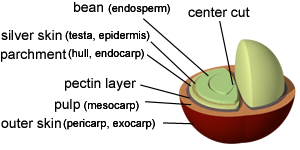
Coffee History and Amazing Facts
This Coffee History and Amazing Facts article provide a brief introduction to becoming an expert in coffee. It would take books and also lots of practical experience in brewing and tasting coffee to make you a true expert. If that’s your goal, that’s wonderful! You can start your journey at the National Coffee Association USA website and then branch out from there. Try various coffees, coffee blends as well as coffees brewed in different ways. From traditional Hot brewing to Cold brewing, French press, and other methods. Explore and experiment until you find what’s right for you, or just enjoy it all. Cold and sweet coffee on hot days or hot and black coffee on cold days – who cares, it’s Coffee! Pick what you like and enjoy it!
National Coffee Association USA

